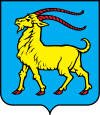Poreč
Poreč (Latin: Parens or Parentium; Italian: Parenzo; Ancient Greek: Πάρενθος, romanized: Párenthos) is a town and municipality on the western coast of the Istrian peninsula, in Istria County, Croatia. Its major landmark is the 6th-century Euphrasian Basilica, which was designated a UNESCO World Heritage Site in 1997.[4]
Poreč | |
|---|---|
| Croatian: Grad Poreč Italian: Città di Parenzo[1] City of Poreč | |
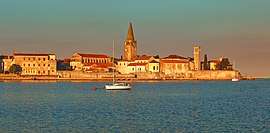 .jpg) 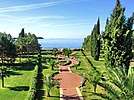 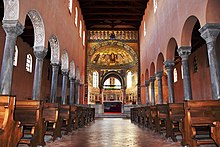      Poreč | |
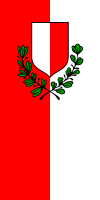 Flag | |
 Poreč | |
| Coordinates: 45°13′38″N 13°35′45″E | |
| Country | |
| County | |
| Government | |
| • Mayor | Loris Peršurić[2] (IDS) |
| • City Council | 17 members
|
| Area | |
| • Total | 139 km2 (54 sq mi) |
| Elevation | 29 m (95 ft) |
| Population (2011)[3] | |
| • Total | 16,696 |
| • Density | 120/km2 (310/sq mi) |
| Time zone | UTC+1 (CET) |
| • Summer (DST) | UTC+2 (CEST) |
| Postal code | 52 440 |
| Area code(s) | 052 |
| Website | porec.hr |
The town is almost 2,000 years old, and is set around a harbour protected from the sea by the small island of Sveti Nikola/San Nicola (Saint Nicholas). Its population of approximately 12,000 resides mostly on the outskirts, while the wider Poreč area has a population of approximately 17,000 inhabitants. The municipal area covers 142 square kilometres (55 sq mi), with the 37 kilometres (23 miles) long shoreline stretching from the Mirna River near Novigrad (Cittanova) to Funtana and Vrsar (Orsera) in the south. Ever since the 1970s, the coast of Poreč and neighboring Rovinj has been the most visited tourist destination in Croatia.
History
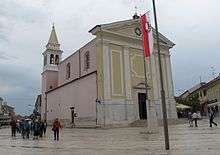

Prehistory
This area has been inhabited since prehistoric times.
Roman period
During the 2nd century BC, a Roman castrum was built on a tiny peninsula with approximate dimensions of 400 m × 200 m (1,312.34 ft × 656.17 ft) where the town centre is now. During the reign of Emperor Augustus in the 1st century BC, it officially became a city and was part of the Roman colony of Colonia Iulia Parentium.
In the 3rd century the settlement had an organised Christian community with an early-Christian complex of sacral buildings. The earliest basilica contained the remains of and was dedicated to Saint Maurus of Parentium and dates back to the second half of the 4th century. The floor mosaic from its oratory, originally part of a large Roman house, is still preserved in the garden of the Euphrasian Basilica.
Middle Ages
With the fall of the Roman Empire in 476, different rulers and powers governed. First, it was held by the Ostrogoths and after 539 was part of the Byzantine Empire. From 788 it was ruled by the Franks. A short independence period followed in the 12th century and later it was ruled by the Patriarchate of Aquileia. In 1267 Parenzo became the first Istrian city that chose to become part of the Republic of Venice, whose rule lasted for more than five centuries. During this period several palaces, squares and religious buildings in Venetian style were built. In 1354 the city was destroyed by the Genoese. In 1363 the town was given the City Statute.
Modern period
The population was decimated by plague at the end of the 16th and the beginning of the 17th century. After the fall of the Venetian Republic, Parenzo came under the sovereignty of the Habsburg Monarchy.
Between 1805 and 1814, Parenzo was part of the Napoleonic Kingdom of Italy and then of the Illyrian Provinces, nominally part of the First French Empire. After this period it was again annexed by the Habsburgs, with the Monarchy reorganized into the Austrian Empire. In 1844 a steamship connection was established between Parenzo and Trieste.
In 1861, under Austrian Littoral Parenzo became the seat of the regional Parliament, with schools, administrative and judiciary offices, and other services. During this time, it slowly became a shipbuilding center. It also became a popular tourist resort for the Austro-Hungarian aristocracy. Between 1902 and 1935 the Parenzana (from the name 'Parenzaner Bahn'), a narrow-gauge railway line connected the town to Trieste.
After 1918, it became part of the Kingdom of Italy. In 1944, the city was bombed by the Allies 34 times, damaging 75% of the city.[5]
Yugoslav period (1945/47-1991)
In 1947, two years after World War II, it was occupied by Yugoslavia and the city name was changed into Poreč. The Italian population left the city and was replaced by Slavic people from different regions of Yugoslavia.[6]
From 1945 to 1991, Poreč was a city of Croatia, then part of the Socialist Federal Republic of Yugoslavia.
Climate

Situated on the western coast of Istria and cooled by sea breezes, the local climate is relatively mild and free of oppressive summer heat. The month of July is the hottest, with a maximum air temperature of 30°C in conditions of low humidity, while January is the coldest with an average of 6 °C (43 °F). There are more than 2,400 hours of sun a year, an average of more than 10 hours of sunshine during the summer days. Sea temperatures can reach 28 °C (82 °F), higher than one might expect compared to the coast of southern Croatia where the air temperatures are higher. The average annual rainfall of 920 mm (36.2 in) is more or less equally distributed throughout the year, although July and August are very dry.[9] Winds here are the Bora, bringing the cold, clear weather from the north in the winter, and the Jugo, a warm southern wind bringing rain. The summer breeze that blows from the sea to the land is called the Maestral.
Nearby sightseeing sites
The Baredine Cave, the only open geological monument in Istria, is in the vicinity. Stalagmites in the cave are known for their curious shapes. One is said to resemble the Virgin Mary, another the Leaning Tower of Pisa.[10]
Lim Bay is a 12-km long estuary with the aspect of a narrow canal, created by the river Pazinčica by eroding the ground on its way to the Adriatic Sea. Quartz boulders are occasionally found here, exposed by the sea.
Vegetation and agriculture
The landscape is rich in Mediterranean vegetation, with pine woods and green bushes, mostly of the holm oak and strawberry tree. For generations, the fertile blood-red land (crljenica) has been used for agriculture, with cereals, orchards, olive groves and vegetables the main crops. Today the production of organic food is significant, including olives, grapes, and popular wines such as Malvazija, Borgonja, Merlot, Pinot, Cabernet Sauvignon and Teran.
Transportation
%2C_Pore%C4%8D074.jpg)
Road traffic is the primary form of transportation. Poreč is well-connected with the rest of Istria and with larger cities such as Trieste, Rijeka (Fiume), Ljubljana and Zagreb. The nearest commercial airport is in Pula (Pola). Sea traffic is less important today than it was in previous centuries; these days it is primarily used for tourist excursions. The closest railway station is in Pazin (Pisino), which is the seat of the Istria County local authority. Between 1902 and 1937 the Parenzana, a narrow-gauge railway line connected the town to Trieste.
Economy
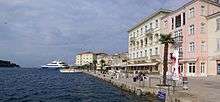
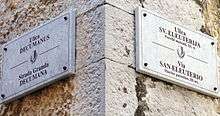
| Year | Pop. | ±% |
|---|---|---|
| 1880 | 7,355 | — |
| 1890 | 8,478 | +15.3% |
| 1900 | 10,168 | +19.9% |
| 1910 | 12,439 | +22.3% |
| 1921 | 12,252 | −1.5% |
| 1931 | 12,607 | +2.9% |
| 1948 | 9,862 | −21.8% |
| 1953 | 8,604 | −12.8% |
| 1961 | 8,216 | −4.5% |
| 1971 | 8,820 | +7.4% |
| 1981 | 11,739 | +33.1% |
| 1991 | 14,633 | +24.7% |
| 2001 | 17,460 | +19.3% |
| 2011 | 16,696 | −4.4% |
| Source: Naselja i stanovništvo Republike Hrvatske 1857–2001, DZS, Zagreb, 2005 | ||
Traditionally, economic activities have always been connected with the land and sea. The only significant industry in the area is food processing, but Croatia's ongoing integration into the broader European economy has led to Poreč seeing growth in its trade, finance and communication sectors. However, the primary source of income is tourism.[11]
Real estate prices are very high due to the city's prime location.
Demographics
According to the 2011 census, the main ethnic groups in Poreč are Croats (74.8%), Italians (3.2%), Serbs (3.4%), Albanians (2.7%) and Bosniaks (1.95%).[12] Also part of the Parentian people submitted the choice "regional" (as Istrian), regardless of their Italian or Croatian origin. In the common use Italian is spoken by 15% of the local population. According to the census, there are 9.790 residents of the town of Poreč. With all suburban areas included, municipality of Poreč has a total of 16.696 residents.
Main sights
The town plan still shows the ancient Roman Castrum structure. The main streets are Decumanus and Cardo Maximus, still preserved in their original forms. Marafor is a Roman square with two temples attached. One of them, erected in the first century AD, is dedicated to the Roman god Neptune; its dimensions are 30 by 11 m (98.43 by 36.09 ft). A few houses from the Romanesque period have been preserved and beautiful Venetian Gothic palaces can be seen here. Originally a Gothic Franciscan church built in the 13th century, the 'Dieta Istriana' hall was remodeled in the Baroque style in the 18th century.
The Euphrasian Basilica, rebuilt in the 6th century under the Byzantine Empire and bishop Euphrasius, is the most important historical site in Parenzo. It is a protected World Heritage Site, so designated by UNESCO in 1997. Between the 12th and 19th centuries, the city had defensive walls, as the better-known Dubrovnik still does today.
Tourism
In 1844, the Austrian Lloyd steamship company opened a tourist line which called at Parenzo. The first tourist guide describing and depicting the town was printed as early as 1845. The oldest hotel is the Riviera, constructed in 1910. Later came the Parentino and others.
Today, tourist infrastructure is intentionally dispersed along the 37 km (23 mi) long coastline, between the Mirna River and the deep Lim valley. The south hosts self-contained centres like Plava Laguna ("Blue Lagoon"), Zelena Laguna ("Green Lagoon"), Bijela Uvala ("White Cove") and Brulo. To the north, mirroring centres are Materada, Červar Porat, Ulika and Lanterna. In the high season, the area's temporary population can exceed 120,000.
Poreč's heritage can be seen in the historic town centre, in museums and galleries hosted in houses and palaces, many of them still private homes as they have been for centuries. In the off season, weekend visitors from Croatia, Slovenia, Austria and Italy visit the area. Sports complexes are developed and used year-round.
Notable natives
Chronologically:
- Giuseppe Picciola, Italian poet (1859–1907)
- Giuseppe Pagano, Italian architect (1896–1945)
- Mario Visintini (1913–1941), Italian flying ace of the Spanish Civil War and World War II
- Licio Visintini (1915–1942), brother of Mario, Italian naval officer during World War II, member of an elite commando frogman unit
- Rita Rusić (1960), Italian actress, singer and producer
- Simon Sluga (1993), Croatian footballer
Twin town and sister cities



See also
References
- The official site, see also the amendments to the Statute
- http://www.porec.hr/prva.aspx?stranica=56&pid=54
- "Population by Age and Sex, by Settlements, 2011 Census: Poreč". Census of Population, Households and Dwellings 2011. Zagreb: Croatian Bureau of Statistics. December 2012.
- https://whc.unesco.org/en/list/809
- [Tragom povijesti gradske knjižnice Poreč]
- Perselli, G. (2001). I censimenti della popolazione dell'Istria, con Fiume e Trieste, e di alcune città della Dalmazia tra il 1850 e il 1936. Unione Italiana-Fiume, Università Popolare-Trieste, Centro di Ricerche Storiche di Rovigno, Trieste-Rovigno.
- The official site of the City of Poreč, Grad Poreč – Città di Parenzo: http://www.porec.hr/prva.aspx?j=cro
- The document stating the official bilingual name of Poreč: http://www.istra-istria.hr/fileadmin/dokumenti/novosti/sjednice_skupstine_2005/21/21-04.pdf p.3.
- "Poreč". Archived from the original on 2008-08-05. Retrieved 2008-07-30.
- "Cave Baredine". Archived from the original on 2009-03-01. Retrieved 2008-07-30.
- http://www.dzs.hr/Eng/censuses/Census2001/Popis/E01_02_17/E01_02_17_zup18_3484.html
- "Population by Ethnicity, by Towns/Municipalities, 2011 Census: County of Istria". Census of Population, Households and Dwellings 2011. Zagreb: Croatian Bureau of Statistics. December 2012.
External links
| Wikimedia Commons has media related to Poreč. |

- Poreč – Croatian National Tourist Board Website
- Poreč-Parenzo Tourist Office Official Website
- Poreč – Istria Tourist Board Website
- Poreč on the Map – Poreč locations on the map with extended info and historical facts
- Giovanni Maria Cassini (1791). "Lo Stato Veneto da terra diviso nelle sue provincie, quarta parte che compren de porzioni del Dogado e dell' Istria". Rome: Calcografia camerale. (Map of Parenzo region).


